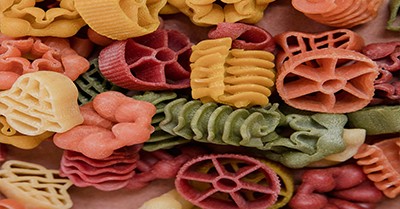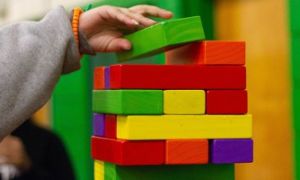Here are some ways to dye pasta, whether for crafts, sensory play, or even naturally coloured edible pasta.
For Crafts & Sensory Play
-
Alcohol & Food Coloring Method:
- Place pasta in a plastic bag.
- Add rubbing alcohol and food dye.
- Shake the bag and let it sit for 10-15 minutes.
- Spread on a tray to dry.
-
Watercolor Method:
- Mix pasta with liquid watercolors.
- Stir until evenly coated.
- Let dry on baking sheets overnight.
-
Vinegar & Food Coloring Method:
- Mix food coloring with vinegar.
- Pour over pasta and shake in a container.
- Spread out to dry.
For Edible Pasta
-
Turmeric Yellow Pasta:
- Mix turmeric with egg.
- Combine with flour and knead into dough.
- Roll and cut into pasta shapes.
-
Naturally Dyed Pasta:
- Use natural ingredients like beet juice, spinach, or saffron.
- Mix with pasta dough for vibrant colors.
Tips For Dyeing Pasta Successfully
Here are some tips to ensure vibrant and evenly dyed pasta:
For Crafts & Sensory Play
- Use Rubbing Alcohol or Vinegar—These help the dye adhere better to the pasta.
- Shake Well—Place pasta in a sealed bag and shake vigorously to distribute the color evenly.
- Dry Thoroughly—Spread pasta on a baking sheet and let it dry completely to prevent stickiness.
- Choose the Right Pasta Shapes—Tube-shaped pasta like ziti works well for jewelry, while bowtie or rotini are great for sensory play.
For Edible Pasta
- Use Natural Dyes – Beet juice, spinach, turmeric, and saffron create beautiful colors without artificial additives.
- Mix Dye with Dough – Incorporate the dye into the pasta dough rather than adding it after cooking for richer hues.
- Cook Carefully – Some colors may fade slightly when boiled, so consider steaming or blanching instead.
Creative Uses For Dyed Pasta
For Crafts & Activities
- Jewelry Making – String dyed pasta onto yarn or elastic to create colorful necklaces and bracelets.
- Sensory Bins – Mix different colors and shapes for a fun, tactile play experience for kids.
- Art Projects – Glue dyed pasta onto paper to make textured mosaics or 3D artwork.
- Educational Games – Use different colors for counting, sorting, or pattern-making activities.
For Cooking & Presentation
- Themed Dinners – Match pasta colors to holidays or special occasions (e.g., red and green for Christmas, pink for Valentine’s Day).
- Rainbow Pasta Dishes – Create a vibrant plate by mixing different colored pasta.
- Party Food – Impress guests with uniquely dyed pasta salads or appetizers.
Further Reading
Benefits Of Sensory Play
Edible Sensory Experiences For Children
Tactile Sensory Play Ideas For Toddlers and Preschoolers
2 Ingredient Sensory Recipe
Sensory Bin Ideas For Toddlers and Preschoolers
References:
How To Dye Pasta, Wiki How
How To Dye Pasta The Easy Way, Happy Hooligans







 As an Educator in Australia, your pay rate falls under the Children’s Services Award 2010. This award states the minimum amount that an employer can
As an Educator in Australia, your pay rate falls under the Children’s Services Award 2010. This award states the minimum amount that an employer can When working as a qualified Early Childhood Teacher (with a university degree) within a service, your rate of pay will come from the Educational Services
When working as a qualified Early Childhood Teacher (with a university degree) within a service, your rate of pay will come from the Educational Services When working as a Diploma Qualified Educator your pay rate is from the Children's Services Award 2010. This Award states your minimum rate of pay
When working as a Diploma Qualified Educator your pay rate is from the Children's Services Award 2010. This Award states your minimum rate of pay When working as a Cert 3 Qualified Educator, your pay rate is from the Children's Services Award 2010. This Award states your minimum rate of
When working as a Cert 3 Qualified Educator, your pay rate is from the Children's Services Award 2010. This Award states your minimum rate of Educational Leaders play a crucial role in their early childhood service by ensuring that the educational program aligns with best practices and supports the holistic
Educational Leaders play a crucial role in their early childhood service by ensuring that the educational program aligns with best practices and supports the holistic In early childhood education and care, ratios are more than a technicality—they are a frontline safeguard. Every child deserves responsive supervision, emotional connection, and developmental
In early childhood education and care, ratios are more than a technicality—they are a frontline safeguard. Every child deserves responsive supervision, emotional connection, and developmental With the new national child safety reforms kicking in on 1 September 2025, early childhood services like yours have a real opportunity to lead the
With the new national child safety reforms kicking in on 1 September 2025, early childhood services like yours have a real opportunity to lead the Here’s a comprehensive Mobile Phone and Smart Watch Policy tailored for early childhood education and care (ECEC) services in Australia, aligned with the latest 2025
Here’s a comprehensive Mobile Phone and Smart Watch Policy tailored for early childhood education and care (ECEC) services in Australia, aligned with the latest 2025 The Sea of Fish Challenge is a national initiative that invites children, educators, families, and communities to create and display fish artworks as a symbol
The Sea of Fish Challenge is a national initiative that invites children, educators, families, and communities to create and display fish artworks as a symbol Across the early childhood education and care sector, educators are sounding the alarm: current staffing ratios are insufficient to deliver safe, meaningful, and developmentally appropriate
Across the early childhood education and care sector, educators are sounding the alarm: current staffing ratios are insufficient to deliver safe, meaningful, and developmentally appropriate


